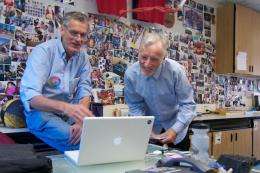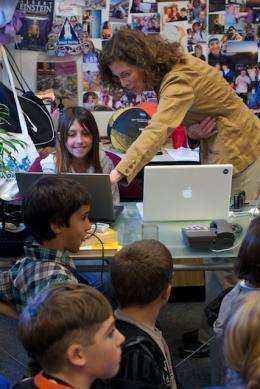Drilling in the name of science

Students in Robert Palassou's fifth-grade class at Valley View School got an unusual treat last month when scientists from NASA’s Ames Research Center visited their Pleasanton, California, classroom and handed them the remote control to a drill being tested in Antarctica.
The primary goal of this year’s field activity is to test the drill in Antarctica’s University Valley. Chris McKay, the principal investigator for IceBite, chose University Valley as the drill’s test site because the terrain there is what McKay calls “dry permafrost,” which resembles the terrain found in 2008 at the landing site of NASA’s Phoenix spacecraft in the northern polar region of Mars. Astrobiology Magazine later this month will post reports from the IceBite team about their University Valley test.
But first, while the IceBite team was still in McMurdo, an Antarctic research station that offers many of the comforts of home, including broadband Internet access, they first performed another critical test of the drill: remote operation. Strictly speaking, remote control isn’t a requirement for operating IceBreaker here on Earth, but making certain the drill can be controlled from afar will be an essential part of any future robotic drilling mission to Mars. For their test, the site the IceBite team chose as a stand-in for Mission Control was Rob Palassou’s fifth-grade classroom.

McKay and Arwen Davé, an IceBite engineer, set up two Internet links to Antarctica: one, on a Mac, a standard Skype connection that enabled the team to talk to the students and the students to watch and listen to the drill; the other, on a PC, containing the drill-control software.
Some one dozen students took turns issuing a series of commands: “Start,” telling the drill to begin spinning; “Seek,” telling the drill to move down until its bit made initial contact with the ground surface; “Drill,” telling the drill to, well, drill; and finally, “Retract,” telling the drill to return to the surface with a subsurface sample of ice and soil.
IceBreaker is a rotary percussive drill, so addition to spinning, its drill bit hammers on its target. As operations proceeded, the students were able over the Skype connection to watch the drill’s progress and listen to the rattletrap hammering sound it made as it pounded away at the frozen ground. In between drilling runs, IceBite team members in Antarctica talked to the students, filling in details about what was taking place on their end of the operation.
From the perspective of the IceBite team, the test was a success, and the drill collected several samples that will be sent back to California for analysis, some to NASA Ames, and some to Palassou’s classroom.
Palassou thought it was pretty successful from the kids’ perspective as well. “On an excitement level, I would say [they’re] almost off the charts excited. They were just giddy about it,” he said.
His students agreed.
Noah Avery “thought it was really cool and exciting to learn about Mars and understand what the scientists are doing now.”
Arnel Ilic, one of the students who operated the drill, said, “It was really fun to control it…. It was really cool how when you pressed the button and you did ‘Send Command’ that it actually worked in a place really far away.”
Lauren Dennen was inspired “to think about the possibility of me being someone who works for NASA, because I never knew that being a scientist could be so fun. Like you get to invent things and you get to explore and I just think it would be really, really fun if you could be able to just think about ideas and figure out that maybe your idea would work and land somewhere.”
Palassou, who has worked previously with McKay as part of Spaceward Bound, a program that brings scientists and K-12 teachers together in the field to develop hands-on science education, encourages his kids to take an experimental approach even to recess. While we were talking outside after the drill test, a group of kids ran up to him excitedly, one of them with a praying mantis on his finger. When they had trouble getting the mantis to return to the grass, Palassou suggested they “try different guesses” and “find a procedure that’s not going to damage it and get it off of you over time. Give it a few minutes.”
A strong proponent of bringing scientists into elementary-school classrooms, he said the incident was a good “argument for why you want to work with elementary school kids. Because they still have that, ‘Look, I found a praying mantis, Mr. Palassou!’”
Or, as Arnel put it: “If I was an adult and I worked for NASA, I would try to convince NASA to let elementary schoolers … do some experiments. Cause you never know, something might just catch their eye at any moment and they would want to try it.”
Source: Astrobio.net



















